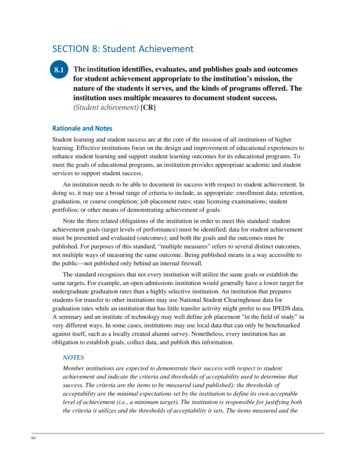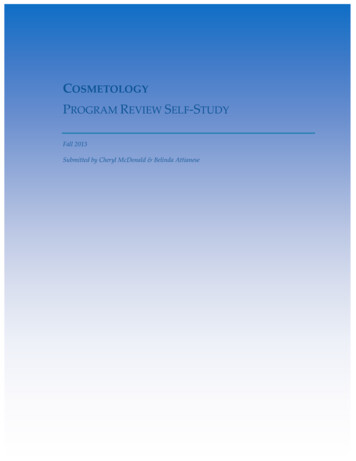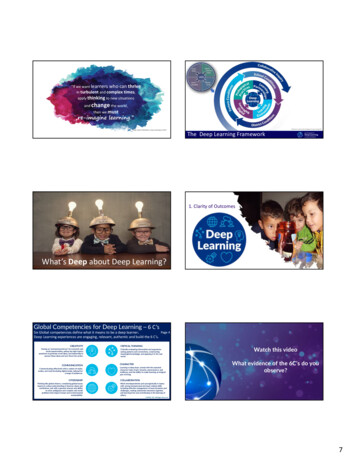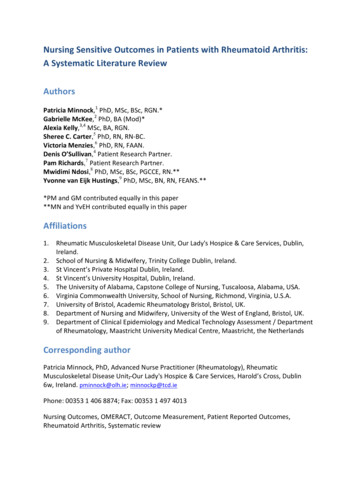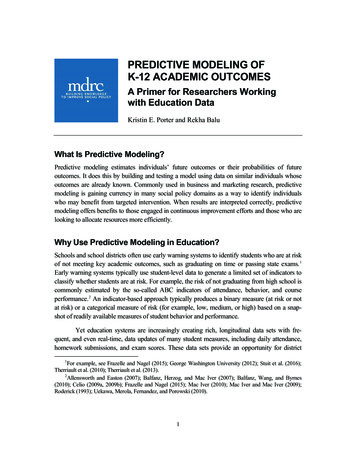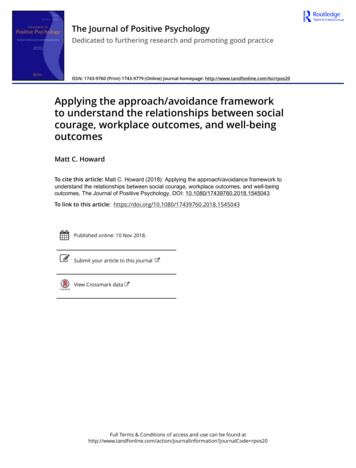
Transcription
Desktop Publishing5N0785learning outcomes 1, 2 & 4:Desktop Publishing Theory1. Contents1. Learners will be able to distinguish between desktop publishing and other forms of documentproduction with reference to purpose, development process, and specialised DTP roles:. 1A.Desktop Publishing (DTP) - Purpose . 1B.Another form of Document Production – Word Processing . 1C.Explain the difference in using page layout software over a word processor . 2D. Describe different page layout software such as Adobe InDesign, QuarkXPress, MicrosoftPublisher etc. and give advantages and disadvantages between them . 2Some common Desktop Publishing Software is as follows: . 2Features of DTP Software Applications . 3Advantages of DTP Software Applications . 4Disadvantages of DTP Software Applications. 4E.Development Process . 5F.Describe specialist roles in DTP . 6Job Titles: . 6Revision Questions. 8
LO1, LO2 & LO4 Desk Top Publishing1. Learners will be able to distinguish between desktop publishing and other forms of documentproduction with reference to purpose, development process, and specialised DTP roles.A. Desktop Publishing (DTP) - PurposeDTP stands for Desktop Publishing. Desk Top Publishing primarily pertains to designing of documentsusing personal computer loaded with DTP software packages like Page Maker, Coral Draw, MS Word,Venus, Parkashak, etc.You use DTP software to produce professional-looking documents such as reports, books, posters orleaflets. Desktop publishing combines a personal computer and WYSIWYG (what you see is what youget) page layout software to create publication documents on a computer, for both large scale publishingor small scale local multifunction peripheral output and distribution.B. Another form of Document Production – Word ProcessingWord Processing is another method of document production used primarily for the creation of lettersand written documents. Word Processing is a type of software or computer program which allows theuser to type words, sentences, paragraphs and then enhance and manipulate the text to produceprofessional looking typed documents. Word Processors now boast a wide variety of other features suchas charts, tables, mail merge, images and clip art which can be added into documents.DTP InformationDesktop publishing is a term coined after the development of a specific type of software. It's about usingthat software to combine and rearrange text and images and creating digital files. So the term "desktoppublishing" is commonly used to describe page layout skills.The DTP has many advantages in comparison with the manual process. It is a factual and can quickly editwith minimum mistakes. Text and graphics can be merged into single file. Achieve higher productivity,efficiency and quality in printing and publishing with economy. DTP is used for type setting, layout,printing, graphics and photographs etc. With the latest DTP software packages it is possible to undertakea variety of work in the field of printing and publishing.Notes: Desktop publishing is simply a software tool that graphic designers can use to help translatetheir concepts and ideas into the proper format for printing. But desktop publishing software is also atool that anyone can use to create and print their own designs as well.Page 1
LO1, LO2 & LO4 Desk Top PublishingC. Explain the difference in using page layout software over a word processorDTP software gives you more control over the layout of a page than a word processor and lets you easily integrategraphics into your publications.Word Processing programs are designed to focus on texts whilst Desktop Publishing devices are designed to focusmore on the structure or display of a document.WPs are generally more condensed then DTPs and so are better suited for transferrals across the internet. Smallerfile size.DTP programs give the user the tools required to greatly edit a piece of graphic whilst WPs only allow the mostsimple edits to graphic such as changing of its size inside a file. However WP programs allow one to moreeffectively edit text then a DTP.DTPs also make it possible for people to save money on the designs of their documents. WPs do not essentiallyoffer this because whilst there are professionals who are experts in using DTP programs WPs have never been anindustry in its own. E.G. one cannot really make money from being an expert in Word processing programs.D. Describe different page layout software such as Adobe InDesign, QuarkXPress,MicrosoftPublisher etc. and give advantages and disadvantages between themSome common Desktop Publishing Software is as follows: Adobe InDesign Adobe PageMaker CorelDRAW Corel Ventura iStudio Publisher Microsoft Office Publisher QuarkXPressPage 2
LO1, LO2 & LO4 Desk Top PublishingAdobe InDesign is a desktop publishing software application produced by Adobe Systems. It can be used to createworks such as posters, flyers, brochures, magazines, newspapers and books. InDesign can also publish contentsuitable for tablet devices in conjunction with Adobe Digital Publishing Suite. Graphic designers and productionartists are the principal users, creating and laying out periodical publications, posters, and print media. It alsosupports export to EPUB and SWF formats to create digital publications, and content suitable for consumption ontablet computers. The Adobe InCopy word processor uses the same formatting engine as InDesign.Microsoft Publisher is included in higher-end editions of Microsoft Office, reflecting Microsoft's emphasis on theapplication as an easy-to-use and less expensive alternative to the "heavyweights," with a focus on the smallbusiness market where firms do not have dedicated design professionals available to make marketing materialsand other documents.However, it has a relatively small share of the desktop publishing market, which isdominated by Adobe InDesign and QuarkXPress.[1] Publisher has historically been less well liked among high-endcommercial print shops, compared with other desktop publishing applications.QuarkXPress is used by individual designers and large publishing houses to produce a variety of layouts, fromsingle-page flyers to the multi-media projects required for magazines, newspapers, catalogs, and the like.QuarkXPress once dominated the market for page layout software with over 95% market share amongprofessional users. While one publisher estimates that share has fallen to below 25% and Adobe InDesign is nowthe market leader, QuarkXPress still has significant marketshare.A user may choose to produce work in another package rather than directly using a desktop publisher as the otherpackage may offer better features than the desktop publisher. For example a spreadsheet will probably be capableof producing better charts than a DTP program could.Features of DTP Software Applications Probably the best known application of this type is Microsoft Publisher. It is an intermediateapplication - intermediate is defined in terms of capability and price. Page icons - This is the “booklet” feature—a basic feature of any DTP application. It is very usefulfor multi-page newsletters, among other things. Guides - Another basic DTP feature, the guides can be very precisely positioned, which meanstext and graphics can be very precisely positioned. Autoflow -you can automatically thread text among several pagesPage 3
LO1, LO2 & LO4 Desk Top PublishingAdvantages of DTP Software Applications In relation to Microsoft Publisher - previous knowledge of Microsoft Word will make it easier tolearn. Suitable for complex documents with multiple pages and a lot of graphics, such as businessdocuments for sales and marketing. PostScript compatible (A computer language that reliably converts the electronic file into aprintable page). Necessary for volume printingDisadvantages of DTP Software Applications Can be very expensive Requires a lot of study to learn how to use all of the features – when compared to a wordprocessor. The more complex the application, the steeper the learning curve.Notes:Page 4
LO1, LO2 & LO4 Desk Top PublishingE. Development ProcessThe Development Process can be seen as a cycle one example of this is as follows:The Design ProcessDesign A brief description of what you have been asked to make and who it isfor.BriefTaskAnalysisResearch A brainstorm of key decisions that need to be made at the start of theproject. List as many questions and possible options as you can aboutthe project you are attempting Finding out the answers to the questions you asked in your taskanalysis. For example, you might need to find out more about yourtarget market or existing products A clear list of goals and targets that you want your design to achieve.SpecificationInitial Sketches of as many different designs as possible, with annotations toexplain how the designs might be madeDesignDesign Selection of one of your designs using sketches and words to show howit can be improved.Development A detailed plan of how to make your product and to ensure that it ismade to a good standard.Planning An analysis of how good your final product is and how it could beimproved.EvaluationPage 5
LO1, LO2 & LO4 Desk Top PublishingF. Describe specialist roles in DTPBelow you will find listings for the most frequently used job titles within the DTP world. They havedivided them into Operations, Management and Peripheral ator,PowerPoint Specialist, Word Specialist, CreativePresentations Operator, DTP Operator, DTP Secretary, Template/VBA Developer, ReprographicsOperatorManagementDTP Manager, Team Leader, Workflow Coordinator, Shift Supervisor, Graphics Manager, MarketingManager, Bid Manager, Proposals ManagerPeripheralMicrosoft Office Trainer, RFP/Bid Writer, Research Assistant, Pitch Designer, Proposals Executive,Marketing ExecutiveJob Titles: desktop publishing specialist desktop publishing technician documentation specialist graphic designer prepress technician In the job market, a desktop publisher is more than just a software user. A desktop publisher isproficient in the use of desktop publishing software — perhaps even having certification inspecific programs such as Adobe InDesign. A desktop publisher uses the computer and software to create visual displays of ideas andinformation. The desktop publisher may receive text and images from other sources or may beresponsible for writing or editing text and acquiring images through digital photography,illustration, or other means.Page 6
LO1, LO2 & LO4 Desk Top Publishing A desktop publisher arranges text and images into the correct visual and digital format for books,newsletters, brochures, letterhead, annual reports, presentations, business cards, and anynumber of other documents. Desktop publishing documents may be for desktop or commercial printing or electronicdistribution including PDF, slide shows, email newsletters, and the Web. The desktop publisherprepares the files in the correct format for the method of printing or distribution.Desktop publisher usually denotes a more technical job; however, depending on the specific employerand job requirements it may also require a greater degree of artistic and design skills and/or writing andediting proficiency.Desktop Publisher Skills and Education For desktop publishers, less formal education including on-the-job or vocational training is oftensufficient for employment. Although a degree is not usually required, there are still certain skillsnecessary to successfully compete for desktop publisher jobs — even as a freelancer. Specificsoftware requirements will vary by employer but general skills and knowledge include advancedPC or Macintosh computer skills, basic to advanced design knowledge, prepress skills, andunderstanding of printing technologies.Notes:Page 7
LO1, LO2 & LO4 Desk Top PublishingLO 1: Revision Questions1. What do the letters DTP stand for?2. Why is a DTP package often used to prepare a document instead of a word processor?3. Explain the difference in using page layout software over a word processor?4. Name 3 different brands of page layout software?5. There are 8 stages in the Design Process name each stage.6. What is the role of a Desk Top Publisher? How does this role distinguish from someone who workswith Work Processing software?Page 8
LO1, LO2 & LO4 Desk Top Publishing2. Learners will be able to describe the characteristics of key components of DTP systems includingthose used for input, storage, protection, processing, output, and transmission of images and data.A. Describe a typical DTP system specification such as operating system, RAM capacity, diskformats and capacities, CPU speed, VDU type, printer type and resolution, scanner type andmaximum possible resolution.B. ComponentsA computer component is a computer part or hardware. These can be divided into two groups, thecomponents inside the tower and the components we can see.Main Components of a Computer Processing System – Inside the Towera.b.c.d.Hard DriveCPU Central Processing UnitMotherboardPSU Power Supply Unite.f.g.h.RAM Random Access MemoryModemVideo CardNetwork CardHard DriveLike the filing cabinet inside your computer. This stores all of your programsand files its size is measured in GB (the more GB, the more you can store).The average size today is upward of 120GB.CPU Central Processing UnitThe CPU stands Central Processing Unit - the 'brain' of the computer. This isone of the smallest yet most expensive parts of a PC. When people talkabout the speed of a computer they are talking about the speed of the CPU.The CPU interprets the instructions you give the computer and then carriesout the task. The speed of a CPU is measured in Mhz and Ghz (the more Mhz the faster the PC) andthe bigger your CPU the faster a computer can work. Manufactures include Intel, AMD and IBM.Page 9
LO1, LO2 & LO4 Desk Top PublishingMotherboardThis is the main board on the computer. All the components slot in or connectto the motherboard it is a very complicated and intricate.PSU Power Supply UnitThis is where the mains power plugs into the computer. It is located at the back of the computernext to the fan which keeps it cool. The PSU has lots of cables connected to it which can plug intothe components on the PC including the CD ROM, Hard Drive, Fan and Motherboard.RAM Random Access MemoryRAM - stands for Random Access Memory. This is a temporary type of memory usedwhile you are working on your computer (where your work is saved before youactually save it). It is the memory a computer needs to run software. When you loador 'run' software, it goes into RAM. If you type something it also goes into RAMbefore being saved on the hard disk. When you turn your computer off all the data inRAM is lost. The performance of RAM is measured in MB, the more MB of RAM a PChas, the better it can cope with big tasks like having lots of applications open at once, if you have asmall amount of RAM the PC will crash and become very slow. RAM can be easily added to acomputer to improve its performance.ModemThis is what is used to connect a computer to the internet it connects though a phone line. Theperformance of a modem is measured in KB. The speed of modems is limited by phone lines (thatis why we now have broadband).Video CardA video card sends the picture signals from the motherboard to themonitor. The video card is inserted into the mother board like the RAM.It interprets what needs to be displayed and passes the message on tothe monitor. You can get powerful 3D cards for games, some videoPage 10
LO1, LO2 & LO4 Desk Top Publishingcards are so fast they have to have their own fans. Performance of video cards is measured in MB(the more ‘MB’ the faster the picture appears). Average size today is about 64mb.Network CardNetwork cards (network interface controller) are used to connectcomputers to a computer network; all the computers in the collegehave a network card so they can talk to each other. The speed of anetwork card is measured in MB per second.C. Input DevicesKeyboardKeyboards are one of the two basic components used for data entry. Keyboards use the Qwertytyping layout similar to typewriters. Keyboards usually also have a number keypad to the rightwhich can be used to enter numeric data.MouseTouch sensitive screenMicrophone (voice data entry)ScannerIn computing, an image scanner—often abbreviated to just scanner—is adevice that optically scans images, printed text, handwriting, or anobject, and converts it to a digital image. Common examples found inoffices are variations of the desktop (or flatbed) scanner where thedocument is placed on a glass window for scanning.Smart CardsA smart card, chip card, or integrated circuit card (ICC), is any pocketsized card with embedded integrated circuits. A smart card or microprocessor cardscontain volatile memory and microprocessor components. The card is made of plastic.Page 11
LO1, LO2 & LO4 Desk Top PublishingSensors e.g. alarms, climate controlA sensor also called detector is a device that measures aphysical quantity and converts it into a signal which canbe read by an observer or by an instrument. Sensors areused in everyday objects such as touch-sensitive elevatorbuttons (tactile sensor) and lamps which dim or brightenby touching the base. There are also innumerableapplications for sensors of which most people are neveraware. Applications include cars, machines, aerospace, medicine, manufacturing and robotics. Asensor is a device which receives and responds to a signal.Sensors are used in alarms and in climate control to detect changes and computers can reactaccording to the changes appropriately for e.g. Fire alarm, burglar alarm, air conditioning and arefrigerator.D. Output Devices - PrintersThe three main different types of printers are: Ink-jet PrintersLaser PrintersMultifunctionalNormally home computer users will use ink-jets as they are relatively cheap but superior in qualityto dot-matrix. Laser jets and other printers created by new technology are more expensive andmore commonly found in the offices.InkjetInk-jets(bubble-jets) printers spray ionized tiny drops of ink onto a page tocreate an image. This is achieved by using magnetized plates which direct theink's path onto the paper in the desired pattern. Almost all ink-jets offer acolor option as standard, in varying degrees of resolution. Ink-jet printers arecapable of producing high quality print which almost matches the quality of a laser printer. APage 12
LO1, LO2 & LO4 Desk Top Publishingstandard ink-jet printer has a resolution of 300 dots per inch, although newer models haveimproved on that. As a rule color link-jet printers can also be used as a regular black and whiteprinter.When a Color Inkjet Printer is the Best ChoiceInk jets are a good choice if you are looking for high quality color photo output for a reasonableprice. Prices start at around 150.First, you'll need to decide on the type of machine you want: a standard ink jet for reasonablephotos and a low purchase price, or a photo ink jet for superior photo quality. All of the top modelsoffer 4800-by-1200-dpi resolution, but they vary quite a bit in terms of printing speed.Choose an inkjet printer based on the cost of replacement ink cartridges, and not on the cost of theprinter. Over time ink and paper costs can exceed the cost of the printer several times over. Avoidsingle-cartridge printers which only come with a color cartridge that can't print true color. It is morecost effective to purchase a color inkjet with multiple color cartridges (CMYK), so they can bereplaced individually.Another cost saving tip: Leaving any inkjet idle for even a week or two can allow the ink in the tinytubes that feed the nozzles to dry. The resulting clogs cause streaks and other anomalies in yourpictures. To avoid clogs, print at least once a week. Some printers run a maintenance routine onstartup, meaning that you can keep the nozzles clear simply by turning your printer on and off oncea week. Check your device's manual to see whether it has this feature.LaserJetLaser printers operate by shining a laser beam to produce an image on a drum. Thedrum is then rolled through a pool, or reservoir, or toner, and the electricallycharged portions of the drum pick up ink. Finally, using a combination of heat andpressure, the ink on the drum is transferred onto the page. Laser printers print veryfast, and the supply cartridges work a long time. Color laser printers use the same toner-basedprinting process as black and white (B/W) laser printers, except that they combine four differenttoner colors. Color laser printers can also be used as a regular black and white laser printer.Page 13
LO1, LO2 & LO4 Desk Top PublishingWhen to Choose a Laser PrinterIf you do a lot of document printing, don't use an inkjet printer. Use a laser printer. Laser printerscost more to buy but much less to use - they are very cost effective to operate since their tonercartridges are not replaced as often.With all costs figured in, each document page printed on a typical laser printer costs from 2 cents to5 cents; on an inkjet, the cost per page can run from 10 cents to 15 cents, depending on the model.(This does not even count the cost of photo printing, which can cost up to a eurp per page on aninkjet when you include the high cost of photo paper and the additional ink that's used in thatmode.)Digital Photo printersMany middle range printers are now able to print photo quality images.Usually an option with color printers, specialist photo print heads allow agreater resolution to be achieved to improve photo image quality. Photo inkjet printers expand their gamuts by adding additional ink colors, usually lightcyan and light magenta.Multifunction PrinterMultifunction printers combine top-quality color ink-jet or laser printingwith plain-paper and PC faxing, color copying and color scanning ,telephoning- all in one convenient, space-saving machine. If you work from home or have a smalloffice a multifunctional device may be ideal.Page 14
LO1, LO2 & LO4 Desk Top Publishing4. The learner will be enabled to describe the legal implications associated with use andprotection of published material including licensing and copyrightIdentify some of the legal implications involved in the publishing process e.g. copyright,licensing etc.A. What is Copyright?Copyright is the legal term, which describes the rights given to authors/creators of certaincategories of work. Copyright applies to all sorts of written and recorded materials from softwareand the internet to drawings, photography, films and music.In Ireland, copyright law is contained in the Copyright & Related Rights Act, 2000.Copyright protection extends to the following works: original literary, dramatic, musical or artistic workssound recordings, filmsbroadcasts, cable programmesthe typographical arrangement of published editionscomputer programmesoriginal databasesHow do I register a copyright in Ireland?In Ireland, copyright is automatic.There is no system of registration for copyright protection in Ireland as copyright arisesautomatically on the creation of an original work. You do not need to publish your work, to put acopyright notice on it or do anything else to be covered by copyright – protection is free andautomatic.A work is protected automatically from the time it is first written down or recorded in some way,provided that it has resulted from the creator’s skill and effort and is not simply copied fromanother work.There are two ways of doing this:1. Deposit a copy of the work with an acknowledged representative (who may be a bank orsolicitor) in such a way as to allow the date and time of the deposit to be recorded or notarised.Page 15
LO1, LO2 & LO4 Desk Top Publishing2. Send a copy of the work to oneself by registered post (ensuring a clear date stamp on theenvelope), retaining the original receipt of posting and leaving the envelope containing thecopyright work unopened thus establishing that the work existed at that date and time.How long does Copyright last?The Copyright protection for literary, dramatic, musical and artistic works expires 70 years after thedeath of the author/creator. If the copyright is still in force it would be necessary to get thepermission of the owner of the copyright to reproduce the work no matter what language it is in.It should be noted that the duration of copyright in Ireland may differ from other countries e.g. theduration for sound recordings in the USA is 95 years from the date it was made available to thepublic whereas in Ireland, it is only 50 years.B. Copyright and licensingCopyright is a property right which – like other property rights – may be the subject of various typesof transaction. It may be sold outright (by an “assignment”, which must be in writing), or licensed inwhole or in part. Licences are often for a short term and cover only certain uses of the work. Forexample, you might grant a licence to a hotel chain for the use of a work in a newspaper advertisingcampaign, for a period of two years. While an assignment must be in writing, a licence can beverbal, although it is unwise to give any permission for the use of a work without some writtenevidence of the agreement.If I have paid for someone else to create something, will I own the copyright?Unless it is specifically stated in the contract commissioning the work that you or your business willown the copyright in the work that you have paid for, ownership will vest in the the first owner ofcopyright which will be the person or organisation that was asked to create the work.If the issue of ownership is not mentioned in the commissioning contract, you will need to negotiatethe transfer of the copyright to you. The creator of the work will be under no legal obligation totransfer the copyright to you. For it to have legal effect, an agreement about transfer of ownershipof copyright has to be in writing, signed by or on behalf of the transferor.Page 16
LO1, LO2 & LO4 Desk Top PublishingWhat are moral rights associated with copyright?The concept of moral rights in copyright works was introduced into Irish law by the Copyright &Related Rights Act 2000. These moral rights are: the paternity right (the right to be identified as theauthor of the work); the integrity right (the right to prevent mutilation, distortion or otherderogatory alteration of the work) and the right of false attribution (the right not to have a workfalsely attributed to you).(Patents Office)C. Legal Implications - Remedies and Penalties for InfringementCopyright infringement has both civil and criminal dimensions. On the civil side, breach of copyrightis actionable at the suit of the copyright owner and a range of remedies are available, the mostcommon of which are injunctions and damages. On the criminal side, certain acts in relation to thecopyright work are characterised in copyright legislation as offences, for which penalties areprescribed. These offences include, not only the making of counterfeit works but also dealing ininfringing works – by, for example, importing them, selling or renting them. Criminal penaltiesextend to fines of up to 127,000 and/or terms of imprisonment of up to 5 years.(Copyright and the Visual Artist)D. Educational UsesThe use of author’s works for certain educational purposes is permitted. These include the use ofthe work in examinations, and the inclusion of a short passage from the work in an anthology forschools.Further information is available from the Patents Office and the Copyright Association of Ireland.Notes: Copyright restrictions apply on the Internet. Always ask permission when using other people’swork or images. It is permissible to reproduce a small part of a work, where it is relative. Remember tobe aware of bias, propaganda, ethical issues and plagiarism.Copyright applies to all digital media, remember to reference and attribute your source material.If you do decide to include text or images from any source, for example the internet or a book you shouldcontact that site to ask permission to use the material. Otherwise you are infringing on copyright laws.(Nicholson & Dempsey, 2011)Page 17
LO1, LO2 & LO4 Desk Top Publishing5. Additional istory/tp/dtpmyths.htmCopyright Association of Ireland www.cai.iePatents Office y-asked-questions.aspxThere are two types of pages in desktop publishing, electronic pages and virtual paper pages to beprinted on physical paper pages. All computerized documents are technically electronic, which arelimited in size only by computer memory or computer data storage space.Page 18
Adobe InDesign is a desktop publishing software application produced by Adobe Systems. It can be used to create works such as posters, flyers, brochures, magazines, newspapers and books. InDesign can also publish content suitable for tablet devices in conjunction with Adobe Digital Publishing Suite. Graphic designers and production
